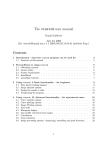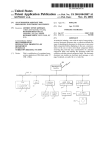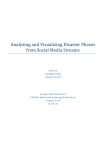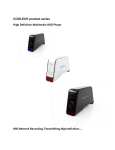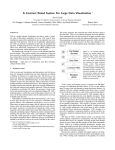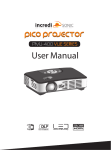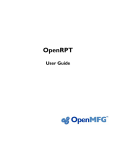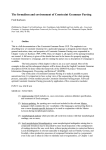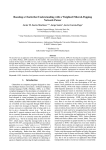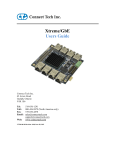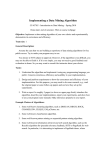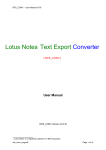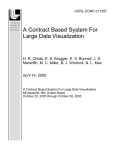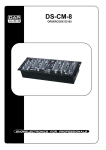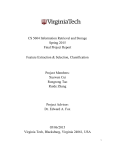Download postscript (gz) - Artificial Intelligence Group
Transcript
Combining Shallow Text Processing and Machine Learning in Real World Applications Günter Neumann DFKI GmBH Stuhlsatzenhausweg 3 66123 Saarbrücken Germany Abstract In this paper, we present first results we achieved and experiences we had combining shallow text processing methods with machine learning tools. In two research projects, where DFKI and industrial partners are involved, German real world texts have to be classified into several predefined categories. We will point out that decisions concerning questions such as how deep the texts have to be analysed linguistically and how ML tools must be parameterized are highly domain and data dependent. On the other hand, there are some constants or heuristics which may show in the right direction for future applications. 1 Introduction The world-wide exponential growth of information brings along the need of tools helping not to loose a general overview. In industry categorial systems in which documents are classified according to themes are often used. This helps to organize information and handle it much more efficiently. Most of the time the classification process itself is done manually which brings about enormous costs both time- and moneywise. Therefore automatic classification systems are very desirable. These systems work mainly in two directions. The first direction makes extensive use of natural language processing tools bringing about high costs in analysing and modelling the application domain but on the other hand promising a very high classification recall/precision value or accuracy. The second direction makes use of statistical methods such as machine learning promising low costs at the expense of a lower accuracy. The idea now is to combine both methodologies in the following way. A shallow text processing (STP) system first extracts main information from texts, then a machine learning (ML) tool either tries to generalize this information for each category and to build a representation for this, i.e. rules or decision trees or simply stores this information and uses distance measures in order to classify new texts. In this approach several questions come to mind: Sven Schmeier DFKI GmBH, Stuhlsatzenhausweg 3 66123 Saarbrücken Germany 1) How deep do we have to analyse texts ? 2) Which learning algorithm is the best and how many training examples do we need ? 3) What can we expect for resulting accuracy ? There is one answer to all these questions: It all depends on the data but our results give some heuristics and hints that might help in other application domains. 1.1 Shallow Text Processing Sof tw are Linguistically based preprocessing of text documents is performed by SMES, an information extraction core system for real world German text processing [Neumann et al, 1997]. The basic design criterion of the system is to provide a set of basic powerful, robust, and efficient natural language components and generic linguistic knowledge sources which can easily be customized to process different tasks in a flexible manner. The essential abstract data types used in SMES are: - dynamic Tries1 for lexical processing: Tries are used as the sole storage device for all sorts of lexical information (e.g., for stems, prefixes, inflectional endings). Beside the usual functions (insertion, retrieval, deletion), a number of more complex functions are available, most notably a regular Trie matcher, and a robust recursive Trie traversal which supports recognition of (longest matching) substrings. The latter is the basic algorithm for on-line decomposition of German compounds. - weighted finite state transducers (WFST): WFST are used in order to represent cascades of grammar modules, e.g., proper name grammars (e.g. organizations, complex time/date expressions, person names), generic phrasal grammars (nominal and prepositional phrases, and verb groups) and clause level grammars. Using WFST supports efficient and robust representation of each individual grammar modul. Fig1 displays the overall architecture of the SMES system. 1 A Trie (also known as letter tree) is an tree-based datastructure for efficiently storing common prefixes of words [Aho et al, 1982]. Shallow Text Processor Lexical DB > 120.000 stems; > 12.000 verb frames; special name lexica; Tokenization Text Lexical processor • Morphology • Compounds • Tagging Grammars (FST) general (NPs, PPs, VG); special (lexiconpoor, Time/Date/Names) ; general sentence Chunk Parser • phrases • sentences • gram. fct. Set of (partial) parse trees Fig1 It consists of two major components the Linguistic Knowledge Pool (LKP) and STP, the core shallow text processor of SMES. STP consists of three major components: 1) text tokenizer: Each file at first is preprocessed by the text scanner. Applying regular expressions, the text scanner identifies some text structure (e.g., paragraphs, indentations), word, number, date and time tokens (e.g, “1.3.96”, “12:00 h”), and expands abbreviations. The output of the text scanner is a stream of tokens, where each word is simply represented as a string of alphabetic characters (including delimiters, e.g. “Daimler-Benz”). Number, date and time expressions are normalized and represented as attribute values structures. For example the character stream “1.3.96” is represented as “(:date ((:day 1)(:mon 3)(:year 96)”, and “13:15 h'' as “(:time ((:hour 13)(:min 15)))”. 2) lexical processor: Each token that has been identified as a potential wordform is lexically processed by the lexical processor. Lexical processing includes morphological analysis, recognition of compounds, retrieval of lexical information (where retrieval supports robust processing through component based substring matching), and tagging that performs word-based disambiguation.Text scanning is followed by a morphological analysis of inflections and the processing of compounds. The capability of efficiently processing compounds is crucial since compounding is a very productive process of the German language. The output you receive after the morphological analysis is the word form together with all its readings. A reading is a triple of the form “(stem,inflection,pos)”, where stem is a string or a list of strings (in the case of compounds), inflection is the inflectional information, and pos is the part of speech. Currently, the morpholgical analyzer is used for German and Italian. It has an excellent speed (5000 words/sec without compound handling, 2800 words/sec with compound processing where for each compound all lexically possible decompositions are computed). 3) chunk parser: The chunk parser is subdivided into three components.In the first step phrasal fragments are recognized, like general nominal expressions and verb groups or specialized expressions for time, date, and named entity. The structure of potential phrasal fragments is defined using weighted finite state transducers (WFST). As a second stage, the dependency-based structure of the fragments of each sentence is analysed using a set of specific sentence patterns. These patterns are also expresssed by means of WFST. At the final step, the grammatical functions are determined for each dependency-based structure on the basis of a large subcategorization lexicon. SMES has very broad linguistic knowledge source, i.e. a huge lexical data base (more than 120.000 stem entries, more than 12,000 subcategorization frames as well as basic lexica for proper names). It has a broad coverage of special subgrammars for recognizing unknow propername and general grammars for nominal, prepositional and verb phrases. Complete processing of a text with 400 words takes about 1 second. Very important in the context of this paper is SMES's high degree of modularity: each component can be used in isolation. Thus, it is possible to run only a subset of the components, e.g. to peform term extraction by using only the specialized subgrammars or/and the phrasal grammars. 1.2 Machine Learning Sof tw are Several Machine Learning Tools, which stand for different learning paradigms, have been selected and evaluated in different settings of our domains. First, we made use of the MLC++ Library [Kohavi and Summerfield, 1996] which contains several algorithms, i.e. ID3 [Quinlan, 1986], the mother of all decision tree based algorithms; MC4 which combines ID3 and pruning methods of C4.5 [Quinlan, 1993]; IB [Aha, 1992], an Instance Based Learner, equivalent to nearest neighbor learning. We tried out the RIPPER Algorithm [Cohen, 1995] and its boosted version, which both are rule learning algorithms. We did not experiment with Naive Bayes [Langley et al 1992, Good 1965] algorithms2 because of our data format (see 2.1), this is one of our main focus in the current research. Other systems, such as ROCCHIO [Lewis et al, 1996] or SVM-LIGHT [Joachims, 1998], have not been used yet in our scenario because they produce only binary classi2 Our implementation of the Naive Bayes algorithm uses wordfrequencies for computing propabilities. fiers which have several disadvantages in our application domain described by the following two points: 1) The number of classifiers is equal to the number of classes you have in your category system. As we plan the system to be an overnight learning system in order to improve the system’s quality over time, we depend on the statements of our future users whether the system is fast enough to learn several classifiers instead of only one. 2) There is also a problem in determining a representative set of negative examples for one category3 Maybe a great number of tests will be needed to find this set. The clerk then just selects one or more of the proposed possibilities, adds some flowery phrases and sends the reply. In SCEN2 we intend to build a more “classical” textcategorization system which associates press releases with several categories without human interaction. Both scenarios consist of the same general system architecture (Fig.2). In an offline step, texts from an example corpus are passed through our STP module. Its output is then fed to the ML module which creates the categorizer (CAT). In the online step, new texts are again passed through the STP module, its output is given to the CAT which returns the –hopefully right- category. Nevertheless we expect new corpus data that should solve the second problem concerning the number and the distribution of training examples over the categories. The first point can only be solved or answered in the beta testphase (to be started in September 1999) by the future users. Nevertheless we plan our next experiments to cover binary learning systems too. We also tried neuronal network technology, SNNS [Zell,95] but neuronal networks need too much adjusting knowledge especially if there are many input neurons (the number of features in the input vector) and many output neurons (the number of categories). So we didn’t pursue this route. 2.1 Data 2 Application Areas We use the STP and ML techniques in two different industrial research projects. In SCEN1 -ICC (Innovation at the Call Center)- we built an assistance system helping a clerk in a call center with answering questions of a customer. In this call center answers are not formulated spontanously but they consist of preformulated texts which are associated with certain categories. These categories are comparable to a category system used in faq lists. The system’s task is to assign new incoming emails to one or more categories and to propose the preformulated answers. Fig2 OFFLINE vector text STP ML creates vector CAT category ONLINE 3 The numbers of positive and negative examples should not differ too much. The kind of data is essential for STP and ML systems. For STP, the depth of analysis depends very much on the quality of the data. This means that if for example the scanner makes use of punctuation marks to seperate one sentence from another, we must be sure that these marks are set at the right places. Furthermore recognizing whether a point indicates an abbreviation or the end of a sentence is not a trivial task. Morphological information about words is dependent on the lexicon used so we must be sure that the words used in the texts are covered by our lexicon. Further parsing can only succeed if the texts are formed according to grammatical rules or if the parser is very robust. In our examples, the texts in SCEN2 are of a much better quality than the texts in SCEN1. In emails, punctuation marks are used very loosely, we have to cope with a large amount of misspellings and most emails lack grammatical correctness. See the following example: “ Wie mache ich zum mein Programm total deinstalieren, und wieder neu instalierem, mit, wen Sie mir senden Version 4.0 ??????????????” which roughly translates to: “How do I make to mine program totally deinstal, and again new reinstall, with, who you send to me version 4.0 ??????????????”. Here we have problems with wrong placed commas, misspellings (which can hardly be solved by fuzzy matching methods) and the whole sentence is grammatically incorrect (but understandable for persons). In general, the decision on how deep you will do linguistic preprocession depends on the data (because of the pure recall expected). If you go too deep you might not get any results, whereas if you decide to stay on the surface, you will probably get problems in detecting structural similarities in data. Switching over to the ML part, two main issues come into mind: the number of categories and training examples available (and their distribution among the categories) and the length of the texts. In SCEN1 there are 2350 training examples and 44 categories (see Fig3 for distribution). The emails contain 60 words on average. In SCEN2 there are 824 training examples and 6 categories (see Fig4 for distribution). The press releases contain 578 words on average. Fig3 # E x a m p le s 300 250 200 150 100 50 C a ts 0 Fig4 350 # E x a m p le s 300 250 200 150 100 50 0 1 2 3 4 5 6 C a ts We will see that these information have important effects on our results. One last point to mention concerns the noisyness of data. It turned out that the data of SCEN1 is noisier than that of SCEN2 in the following sense: - in some emails several problems are mentioned, i.e. several categories are appropriate - the category system is ambigous by offering several classes for the same problems (highlighting several subthemes) - the example corpus has been “created” by the clerks in the call center and has not been supervised by some expert(s). 2.2 Data Preprocessing We studied the influence of non linguistic and linguistic preperation on data that is fed to the ML programs. We tried simple letter trigrams, morphological analysis of substantives, verbs and adjectives, and shallow parsing methods that extract domain specific information. The main issue of the “deeper” linguistic preprocessing is the combination of domain knowledge with pure statistical methods of the ML part so that we are enabled to avoid counterproductive rules resp. branches. We studied the effects of different input vector sizes i.e. the connection between the number of attributes in the input vector and the texts and expected the following relationship: the more data you have and the longer each text is the more attribute values you should expect. Besides, the use of letter trigrams should enlarge the number of attribute values compared to stemming. However you have to make sure that you do not to run into problems associated with overfitting. So far there is very little agreement on which circumstances determine the length of vectors. Therefore we made several experiments with a smaller dataset, e.g. 5 categories in SCEN1 and a smaller amount of examples in SCEN2 to get a clue to the borders where we could expect a, possibly local, maximum of accuracy. This was the case between 300 and 1000 attributes for SCEN1, and 500 to 6000 attributes for SCEN2. If we go beyond these borders the accuaracy of the performance will decrease. Furthermore we decided not to use wordfrequency measures because –especially in SCEN1- the texts are not long enough and we do not have enough examples to concatenate several texts. So the ML algorithms have to learn “keyword-spotting” rules resp. trees. Notice that extracted tokens have to be reordered in the way that the same tokens occuring in the texts are assigned to the same attributes in the feature vectors. Two ways of reordering come into mind: 1) Use the extracted tokens as attribute names and assign a positive value to this attribute if it occurs in the text. 2) The second algorithm uses the extracted tokens as attribute values and reorders them according to their apperearences. In general both algorithms should produce the same results, we used the second way which gave us the possibility to determine the “degree of generalization”4 simply by changing the length of the vector. 3 Results Now we present our sometimes surprising results ordered by scenario, kinds of preprocessing and ML algorithms. The kind of measurement is “accuracy” which means in average X percent of incoming new texts will be classified into the right category. We preferred this kind of measurement to classical precision/recall measurements because it provides a better overview. We consider it is difficult to have any idea of what 44 precision/recall values of SCEN1 say about the usefullness of the system. All measurements were done using 10 fold cross validation. 3.1 SCEN1 The results we achieved in this project seem to be very bad at first sight. This is due to the fact that the category system does not clearly seperate emails. This means an email can belong to more than one class. As we build an assistance system we do not only take positive solutions into account that are proposed to be the right category with the highest propability but we go down to solutions that are above some threshold. This threshold is defined as follows: During the learning phase we build a confusion matrix, i.e., for each test and for each category the decisions of the categorizer are documented and entered into a table. Each line in this table represents all documents belonging to one category, the values in this line denote the associated classes by the categorizer. In SCEN1 we noticed a close relation between the right 4 i.e., determining a token to be unimportant for a class. categories and the most frequent chosen “wrong” classes. In most cases these classes form a superset of the missing categories needed for multi-class problems which is acceptable for the users. Unfortunately we have not found a way expressing this fact directly in our accuracy values. Empiric measurements tell us that we should add about 20 percent accuracy to each outcome. 3 . 1 . 1 Letter Trigrams We start our test series with letter trigrams. This means you take a window of three letters and shift it over the whole text. For each position you get a token which is appended to the ML input vector. So the sentence “John loves Mary” expands to (“Joh” “ohn” “hn “ “n l” “ lo” ......). Now the results: IB ID3 MC4 RIPPER Boosted R 300 500 28.12 25.12 25.23 41.09 49.39 30.58 27.27 26.65 44.72 50.03 1000 Number of Attributes (#A) 27.28 28.93 28.93 46.54 51.98 We observed that if we increase the number of attributes beyond 1000 the accuracy values would dercrease. We have tested several different vector sizes (600, 750, 900 attributes) just for boosted RIPPER but we never got over 52.5 %. 3 . 1 . 2 M o rpho lo g ica l Ana ly sis In this test we removed all the words except unknown words5, nouns, verbs, adjectives and adverbs. Additionally only the stems of the remaining words – of course unknown words were not stemmed - were put into ML input vector. IB ID3 MC4 RIPPER Boosted R 300 500 1000 #A 31.85 46.01 46.96 52.03 54.76 37.01 46.52 46.43 55.97 58.31 38.15 46.48 46.44 53.95 56.11 This testseries show that in order to analyse short German texts stemming seems to a better choice than simple trigramming. In our opinion this is due to the fact, that the German language has got many different word forms. Furthermore we see that it is not always advantagous to enlarge the number of the vector’s attributes too much without considering which ML algorithm is used. Again the difficulty is to find out which is the optimal length. 3 . 1 . 3 Sha llo w Pa rsing We now switch over from morphological analysis to shallow text processing. This means that by adding domain specific knowledge to the process we shift from the pure statistic approach to a more knowledge based approach. What we have to do now is to detect the main information inside the texts. We found out the main information of the texts in SCEN1 is to be found in sentences containing negation and special words as well as in questions. We extract such information and add it to the vectors of the previous chapter simply by adding a special character to the words found in these sentences (this method has to be refined and we expect better results by using more suitable representations): IB ID3 MC4 RIPPER Boosted R 300 500 1000 22.09 41.17 41.90 49.17 51.12 25.55 42.05 43.12 56.90 59.64 27.01 43.45 44.09 56.14 59.09 #A We see some very surprising results. Although the first four ML algorithms performed worse compared to the previous experiment, RIPPER and its boosted version are slightly improved. The reason for this behaviour has to be explored in future work. 3.2 SCEN2 In contrast to the results in SCEN1 we now obtain concrete results which prognose the future behavior of the system because we are only interested in the categorizer’s favourate category per example data. Again we begin with letter trigramming and go on to morphological anlysis. We didn’t proceed to deeper STP yet but we intend do this in future researches. Remember we now have only 6 categories and rather long, well formulated texts. 3 . 2 . 1 Letter Trigrams Again our first test consists of trigramming the texts and developing the input vectors from these values. We achieve the following results6: IB ID3 MC4 RIP BoR 500 1000 2000 3000 4000 5000 6000 74.74 70.66 69.69 68.19 75.10 76.05 71.85 69.69 69.74 76.09 76.92 72.01 70.21 69.98 76.12 76.75 71.65 68.71 70.12 76.43 77.01 error error 68.43 75.98 75.71 error error 68.89 75.46 75.12 error error 68.22 75.89 5 Due to the very large lexical source we can expect that unknown words are either domain specific expressions or spelling errors. 6 ID3 and MC4 ran out of memory on our Sparc Ultra 4 with 4 cpus and 4096 mByte RAM. Notice that the results are a lot better in this scenario than in SCEN1. This is so mainly because of the smaller number of categories and the kind of categories as they ar not overlapping. 3 . 2 . 2 M o rpho lo g ica l Ana ly sis As in SCEN1 we analyse the texts morphologically and filter out all words except unknown words, nouns, verbs, adjectives and adverbs. The results are: IB ID3 MC4 RIP BoR 500 1000 2000 3000 4000 5000 6000 68.78 68.10 67.42 66.23 78.42 67.93 70.44 68.32 66.83 78.66 67.38 75.24 71.04 66.37 79.14 67.92 72.84 70.36 69.18 79.14 67.33 error error 69.22 79.22 68.05 error error 69.78 78.78 68.73 error error 68.56 79.43 Also in this scenario we see that morpholgical analysis raises the overall performance. Again we see the reason for this in the great numbers of different wordforms in the German language. A second very interesting result is the huge jump of increasing accuracy by using the boosted version of RIPPER. It seems that with longer texts we have a massive amount of overgenerated rules or branches which turn out to be very contraproductive. This point too, is an unsolved secret so far. 4 Summary and Outlook In this paper we presented a system for text categorization consisting of a combination of a STP module and different ML algorithms and evaluated its performance for two different scenarios. We showed many results, attempts to explain them and some unsolved problems, too. We pointed out that different scenarios need different processing methods and learner parameterizations to get the best results. We also saw two constant factors: 1) Linguistic based preprocessing raised the system’s overall performance in both scenarios. We also think that in particular shallow text processing with its high degree of robustness and efficiency is an appropriate means to combine domain knowledge with statistical categorization algorithms. 2) The boosted version of RIPPER promises the best results even under different data preprocessing circumstances. We do not claim that this algorithm works best in general but it worked best compared to the ML algorithms chosen in our scenarios. Our future work will concentrate on both, the linguistic and the statistic modules, i.e., we will define more domain specific parsing rules and we will experiment with further ML algorithms, for example the first order version of RIPPER namely FLIPPER, or WHIRL [Cohen, 1998]. References [Aha, 1992] David W. Aha. Tolerating noisy, irrelevant and novel attributes in instance based learning algorithms. International Journal of Man-Machine Studies, 36(1):267-287, 1992 [Aho et al., 1982] Alfred V. Aho, John E. Hopcroft, Jeffrey D. Ullman. Data Structures and Algorithms 1982: Addison-Wesley [Cohen, 1995] William W. Cohen. Fast Effective Rule Inductionl In ML95, 1995 [Cohen, 1998] William W. Cohen. Joind that generalize: Text Classification Using WHIRL .In KDD-98. [Good, 1965] I.J. Good. The Estimation of Probabilities. An Essay on Modern Bayesian Methods. MIT-Press, 1965 [Joachims, 1998] Thorsten Joachims. Text Categorization with Support Vector Machines. European Conference on Machine Learning (ECML),1997 [Kohavi and Sommerfield, 1996] Ronny Kohavi and Dan Sommerfield. MLC++ Machine Learning library in C++. User Manual. http://www.sgi.com/Technology/mlc [Langley et al, 1992] P. Langley, W. Iba & K. Thompson. An analysis of bayesian classifiers. Proceedings of National Conference on Artificial Intelligence. AAAI Press and MIT-Press, 1992. [Lewis, 1991] David D. Lewis. Evaluating Text Categorization. Proceedings of the Speech and Language Workshop, 1991 [Lewis et al, 1996] David D. Lewis, Robert Shapire, James P. Callan and Ron Papka. Training Algortihms for Linear Text Classifiers. SIGIR, 1996 [Neumann et al, 1997] G. Neumann, R. Backofen, J. Baur, M. Becker, C. Braun. An Information Extraction Core System for Real World German Text Processing. In Proceedings of 5th ANLP, Washington, March, 1997. [Quinlan, 1986] J.R. Quinlan. Induction of Decision Trees. Machine Learning, 1:81-106, 1986. [Quinlan, 1992] J.R.Quinlan. C4.5: Programs for Machine Learning. Morgan Kaufmann, Los Alto, California , 1992. [Zell, 1995] A. Zell et al. SNNS: Stuttgart Neural Network Simulator. IPVR - Applied Computer Science -Image Understanding, Report No. 6/95, 1995






